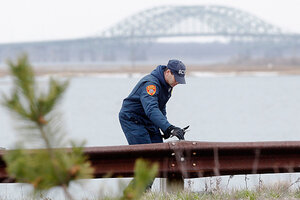Long Island serial killer: Portrait of cunning criminal slowly emerges
Up to 10 human remains have been found alongside a beach highway on Long Island. Four are so far tied to the same elusive killer. But the 'Long Island serial killer' may have been seen and heard.

A member of the Suffolk County police search team looks through a brush area for remains of bodies slain by a possible serial killer near the beach area of Oak Beach, New York, on April 7.
Shannon Stapleton/Reuters
As the manhunt for the so-called Long Island serial killer intensified this week, it's become clear that officials are searching for a crafty criminal who has carefully covered his tracks – but who felt invincible enough to reportedly taunt one victim's family using the missing woman's cellphone.
The remains of at least eight bodies have been discovered since December along beaches of New York's Long Island – at least four of them believed to be victims of one killer. FBI planes and hundreds of agents have joined the all-out hunt, but experts say progress is as likely to come from an unexpected break as from a piece of hard evidence.
So far, there are no actual crime scenes to scour. The victims were killed elsewhere and their bodies deposited along the coast afterward, discovered after extended periods of lying exposed in thick beach scrub. As a result, much of the physical evidence has eroded. Moreover, the murderer has displayed both cruelty and cunning, making it more difficult for police to crack the case, say criminologists.
"Why cases like this are so difficult to solve and why there are unsolved slayings of prostitutes all around the country is that police have very little to go on," says James Alan Fox, a criminologist at Northeastern University, in Boston. "What they have are some remains that they found at a beach, and they're having a hard time figuring out who the victim is, much less who the killer is. Generally in a case like this, police have to get lucky, and they haven't yet."
Since that initial discovery of four sets of human remains in New York's Suffolk County, investigators have found another four or five along similar stretches of beach highway in Suffolk and Nassau counties. The latest two sets of remains were found Monday.
So far, four victims have a unique tie: They were all female prostitutes who advertised on Craigslist. Moreover, they were all killed within the past two years. (Some of the bodies were deposited there earlier.)
The killer may have been seen. One witness on Long Island described seeing a frightened woman, later identified as Shannon Gilbert, scream for help outside his house before she disappeared last May, police say. The witness called the police after she ran off. Minutes later, the witness confronted a man who was looking for the woman. Ms. Gilbert remains missing. The search for her is what led police to find the bodies of the killer's victims.
The killer has also been heard. On Friday, the family of one of the slain women revealed that the presumed killer had called them seven times using her cellphone.
"The fact that he called the family was because he felt he could," says Mr. Fox. "The fact that he didn't use his own cellphone, but the victim's, means he's got to have a certain degree or street smarts or cunning. Since one of the victims was abducted two years ago, he can be pretty smug right now about his ability to evade apprehension."
But as in the case of Joel Rifkin, a Long Island resident who killed at least nine prostitutes in New York City between 1989 and 1993, serial killers are often caught on a fluke or a small blunder. In Mr. Rifkin's case, his car's license plate fell off, leading to a police chase in 1993, after which he was apprehended. In the case of famous serial killer Theodore Bundy, he began to act erratically and was finally caught while driving a stolen Volkswagen van.
"When they remain at large for weeks, months, even years, they can indeed feel superior to the police, so much so that they cut corners a little bit," says Fox.
Local police say they have made some headway. This week, they combed a laptop belonging to a pimp who knew Megan Waterman, one of the victims. They have also questioned guests at a hotel in Hauppage, N.Y., from where she disappeared after traveling there to meet clients for sex.
Without much physical evidence to go on, it's crucial for police to flush out any surviving victims who may be scared to come forward.
"The No. 1 way serial killers are apprehended is by a surviving victim," Louis Schlesinger, a forensic psychologist at John Jay College of Criminal Justice, at City University of New York, tells Time. "Especially early on in a killing series, where the offender has not yet perfected this technique ... somebody may survive."
